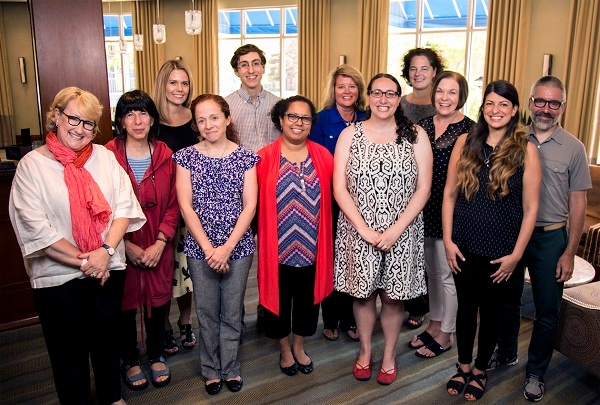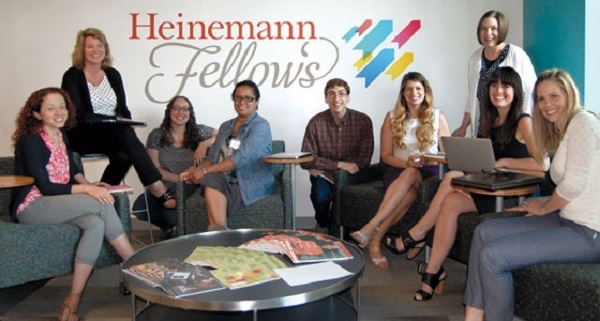
Amy Greenbaum Clark is a Heinemann Fellow with the 2014–2016 class, and has been an educator for 15 years. In today's post, Amy describes how she met students' resistance to poetry with a curriculum of choice and inclusion.
by Amy Greenbaum Clark
This August, I embarked upon an action research journey in hopes of discovering more about the importance of teaching poetry in the English classroom and how it might affect student writing in other genres. I came to this process excited and armed with what I thought were the best methods available to seek the information I desired.
I was confident.
I was ready. I had spent the summer months mapping out this trek—poems were selected, activities and prompts prepped, and all were sequenced to carefully lead to an anticipated destination.
This all sounds ideal, except for the most important part. I had yet to meet my fellow travelers—my students.
We have all had this moment—walking into the classroom overzealous about what would be taught that day only to find that the reality of the situation doesn’t quite match what we’ve planned for. For me, what worked in theory, in that educational utopia of classroom poetry instruction in my mind, was not going to work for the students seated in front of me.
My students were hesitant to write their own poetry.
My kids were quick to criticize the poems I shared with them, finding little merit in meaning or structure. They were also hesitant to write their own poetry, many just putting words on the page without a great deal of consideration. There was no investment. They knew that I was in control of the poems shared as well as the writing assignments offered. I had unwittingly made the mistake of coming in with an agenda and trying to force it when all the while instead of creating a situation that brought my kids to a love of poetry, I was teaching them to resent it.
I couldn’t figure out what I had done wrong. I was bewildered about to how to repair it. And then I made a terrible error. I thought it must be the kids. Despite being incredibly bright, intuitive students, they were shy and reticent to speak in class and for the most part appeared to dislike every poem I shared. Often, my kids seemed frozen by the desire to find the right answer and to phrase it perfectly the first time, as if such a proposition were possible in every scenario. They were not enjoying English class and we seemed to have reached a stand still.
Instead of looking at the poetry instruction I had so carefully orchestrated, I began to break down other aspects of my practice and to place them under a microscope. I spent hours researching better, fresher ways to conduct classroom discussions. I sought more creative assignments that would help offer less predictable opportunities for critical analysis.
My research began to frustrate me. I began to bring less and less poetry into the classroom because I “knew” what the reaction would be. I was ready to change my research question. I was ready to quit. But I was missing the real issue.
Then, two very important moments changed my focus and in turn my practice.
In conversation with Zoe White, a colleague at Heinemann, the question was raised, “Do they have choice about what poems to read? I'm wondering how choice might affect their engagement.” My defensive side immediately asserted that of course I had offered them choice! Choice is the hallmark of my classroom and I’ve known since before I started teaching that it was crucial to engagement.
Except…wait a minute…oh dear…
In all my excitement about my action research, I had removed choice and replaced it with a prescribed curriculum—one that was replete with poems I loved and whose merit as exemplar texts I couldn’t deny. I had become so attached to my choices that I could no longer see the flaws in the method. And even worse, I had blamed the students for my mistake! “How many times have I done this?” I wondered. How often am I teaching what I want to teach without really thinking about what my kids really need and who they really are?
Should I set them free? Should I set requirements?
I knew choice had to be offered but I didn’t know how to make it work. Should I simply set them free? Should I set requirements? Goals? There seemed to be a missing element from all of this. So I sought materials and I read and researched and read some more. And, maybe most importantly, I talked to my students about this process the entire time. I revealed to them the mistakes I felt like I had made and told them that I was seeking a better way and that there would be choice. They were intrigued and curious. As I found books and new ideas, I shared them with my students as well. I wanted them to see that I am constantly learning too and that I passionately sought greater understanding. Suddenly, it was apparent that even though in years past I considered myself and my students part of a community of learners because we read and wrote together, that this conversation was much different and far richer.
In the midst of this research, in November, I found myself at NCTE 2015 in Ellin Oliver Keene’s presentation on engagement. As I sat in that crowded room and listened to her speak about meaningful student engagement, I found myself contemplating this topic far more deeply and in a much different way than I had in my 15 years of teaching. I wanted my students not just to “like” the poems I was bringing in to them, but to have a desire within themselves to learn more and to grow as readers and writers of poetry. I suddenly realized that I couldn’t impose this upon them. It needed to come from within.
So, how would I create this scenario? How would I go about building a framework that offered my students the opportunity to feel this desire to read and write poetry? In my next blog I will share the changes made as well as the profound student response to those changes. This journey has been potentially the most important of my career and it is a joy to share it with you.
♦ ♦ ♦ ♦

Amy Greenbaum Clark is an English teacher at Christ Episcopal School in Covington, LA. Her action research question as a Heinemann Fellow is, "In what ways does the study and composition of poetry impact other modes of student writing; in particular, narrative and scholarly essay writing?"
Follow Amy's progress on Twitter @AmyGClark


